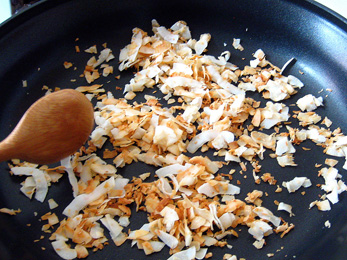
Around this time last year, on those days when wedding planning became just a little too overwhelming, Nathan and I would throw aside our spreadsheets and daydream about our honeymoon instead. Narrowing down our options to a shortlist of destinations turned out to be surprisingly easy since it just so happened that at the top of both of our respective “Places to Travel Next” lists were Spain and southeast Asia. Clearly, we are meant for each other, no? ^_^
Deciding between the two places, however, proved much more difficult.
We consulted friends every chance we got. One of the guys at our favorite sushi spot in the city argued adamantly that we simply must go to Spain, and in particular, Barcelona. A few years ago, he had planned a trip all around Spain starting at Barcelona. Two days after arriving, he tore up his original itinerary and spent the entire vacation in Barcelona. How can we argue with that? Spain, here we come!
Until, that is, we met a couple of family friends for brunch. In the great “Where should Nathan and Angi go for honeymoon” debate of 2009, they were solidly in the opposing camp. As they described the food they ate on their trips to southeast Asia, I had to stop myself from suggesting that we abandoned our eggs benedict and waffles to find some rendang…stat!
In the end, we resorted to pure logistics. With most of my family in Hong Kong, we foresee many trips to Asia in our future and it would be quite easy to take side trips to southeast Asia then. So with that… Vamonos a España!
 |
 |
Just because we haven’t made it to southeast Asia in person yet doesn’t mean we cannot make our apartment smell almost like a kitchen in Indonesia. After some quality time on the internet (mostly by Nathan, who also did pretty much all the cooking for this – lucky me!), we’re armed with a bunch of rendang recipes for inspiration. Rendang originated in Indonesia but has spread to Malaysia and Singapore. It uses many of the same ingredients as a normal curry but the end result is something much drier than a curry, so that the meat is coated in a thick, super flavorful spice crust.
The idea is to make a spice paste with coconut milk, simmer the whole thing until all the water evaporates from the sauce, and let the meat fry in the leftover oil. More often than not, rendang is made with beef. But once you see this photo over on Serious Eats, I hope you will agree that we made the right choice in opting for chicken this time around.
Adapted from this recipe from Serious Eats. Tamarind concentrate and kaffir lime leaves are available at Asian and Indian markets. We usually buy the Maeploy or Chaokoh brands of coconut milk (also at Asian markets), which separate into a cream layer on top and clear liquid below as long as you don’t shake it up. If your coconut milk is not separated, just ignore the part about adding the cream and the clear liquid separately.











18 Comments
This looks great—good job, Nathan! Ming @ LimeTree makes a beef rendang that’s one of our faves, and it’s wet. I actually had no idea that it was supposed to be a dry curry, but it’s an intriguing concept. I do think that beef is OTT rich, so chicken is a good call.
I’m actually tempted to make this with pork shoulder. That would also be rich, but perhaps not as heavy tasting as the beef.
Thanks Ben!
oo, I like the pork shoulder idea a lot – in my mind, I’m imagining and “Indonesian carnitas” especially since you end up frying the meat in oil at the end, except in this case, it happens all right in the pan! I bet in addition to rice, it would be awesome eaten with roti pratha.
I know there’s a chicken redang version out there but haven’t seen it! This looks amazing and I think I’ll like it better than the traditional beef one!
Hi Anh,
Thanks for dropping in! You should definitely give this version a try – we polished the whole thing much quicker than we should have. ^_^
I’m planning to try beef rendang sometime too, but it’ll be hard to resist making chicken rendang again.
angi
Hi, this is the first time visiting your blog. We eat rendang very often in my home country Malaysia. Sometime we cook it with beef too. Hope you can visit Malaysia sometime and I am pretty sure you are going to enjoy the wide range of food there.
Hi Gertrude,
Thanks for visiting! I would love love love to visit Malaysia soon because I know I will love all the food there. ^_^ Malaysia is definitely on my list of places to visit next!
Thanks!
angi
I just posted a recipe of rendang. I tried to make as authentic as I could, thou I live far away from Indonesia. At the Asian markets, rendang instant mix spices are sold, but they still taste different when we make it from scratch.
Originally, this recipe calls for asam kandis (a kind of dried fruit that is giving sour flavour, a family of mangosteen). But, in Java island where asam kandis is not very popular, people substitute for tamarind.
I have planted turmeric to get the leaves for making authentic rendang too :)
Hi Pepy,
I know what you mean about trying to find authentic ingredients. I’m lucky that I live in San Francisco, where there are lots of ethnic grocery markets, so that helps a lot. I’ve never heard of asam kandis though — neat!
Good luck on your turmeric plant and I’m excited to see how you’ll use them in your recipes!
Your photos looks absolutely delicious!I’m saving this recipe to try later!If you won’t mind I’d love to guide Foodista readers to this post.Just add the foodista widget to the end of this post and it’s all set, Thanks!
Thanks Alisa! I haven’t heard of Foodista until now so thanks for letting me know about it. I’ve added the widget to this post and will do so for future posts too.
Hello,
We bumped into your blog and we really liked it – great recipes YUM YUM.
We would like to add it to the Petitchef.com.
We would be delighted if you could add your blog to Petitchef so that our users can, as us,
enjoy your recipes.
Petitchef is a french based Cooking recipes Portal. Several hundred Blogs are already members
and benefit from their exposure on Petitchef.com.
To add your site to the Petitchef family you can use http://en.petitchef.com/?obj=front&action=site_ajout_form or just go to Petitchef.com and click on “Add your site”
Best regards,
Vincent
petitchef.com
This not only sounds wonderful but looks incrediable! Can NOT wait to try it.
I’m bookmarking this recipe! Thanks!
Thanks!
I love your pics! I was browsing through your blog and was itching to leave a comment :) Just few days ago I made beef rendang and my husband was complaining about how I chilibombed the whole apartment. (Just added the last part because feels awkward for just saying how i love your pics)
You are too sweet, Christine – thank you! I really want to make beef rendang too and hey, I think rendang home fragrance is pretty awesome, no? They should bottle that stuff and sell it. :)
looks great-we recently made Floyd Cardoz’s rendang using short ribs, which was quite good and similar to this one. Learning how to use spices is I think an essential skill. Nice job.
Ooo I want to try the short ribs rendang! Nathan and I have been saying that since we started with the less popular chicken rendang, we really must go back the classic beef version. Short ribs would just take it over the top, I think. Thanks for the idea, guys!
I have tried to make this a few times and failed miserably as the chicken was completely falling apart until I made the maybe obvious change of reducing the amount of coconut milk.
Two ideas:
– Cooking it 3/4 through and finishing off on the barbeque
–
2 Trackbacks
[…] all around the globe excel at turning humble ingredients into glorious meals, everything from decadent curries to colorful noodles to hearty bowls of stew. Even within our borders, there are fine examples of […]
[…] – naja, das nächste Mal werde ich die Chilimenge einfach erhöhen Ich habe mich an dieses Rezept gehalten, denn das malyaiische und das indonesische ist wohl ziemlich gleich, wie fast alle anderen […]